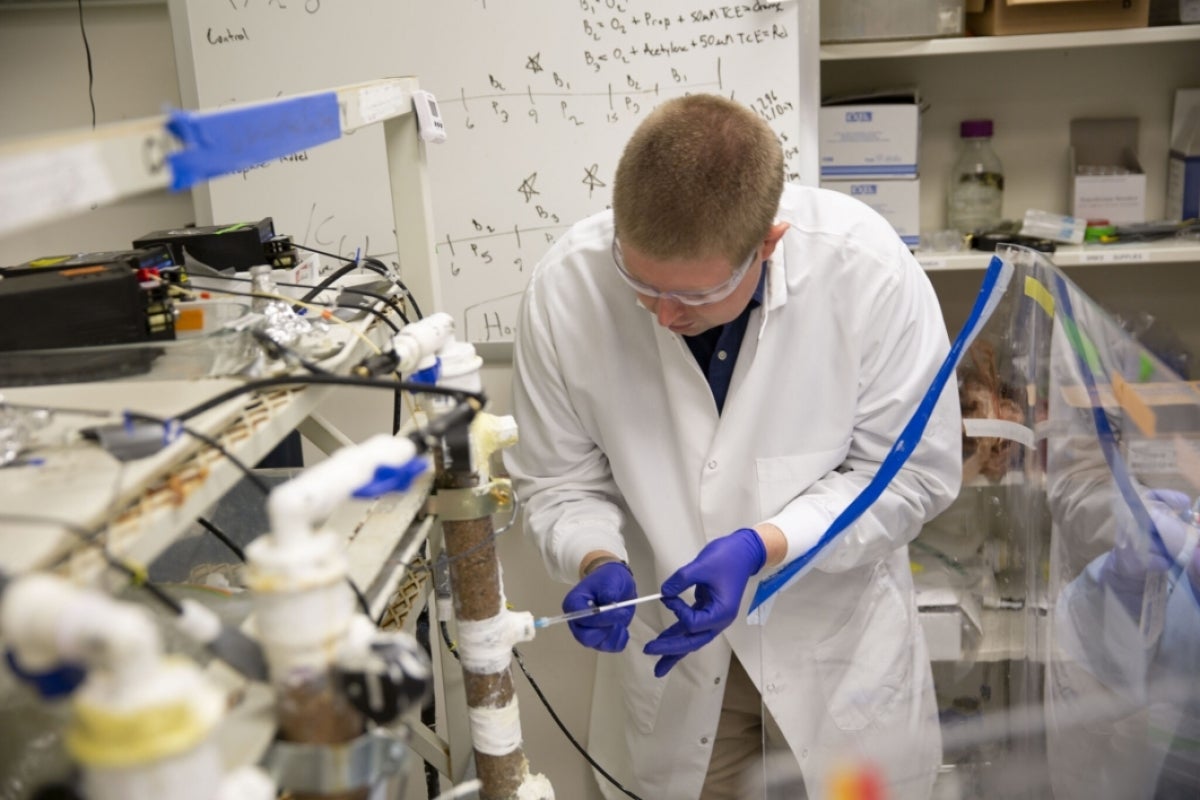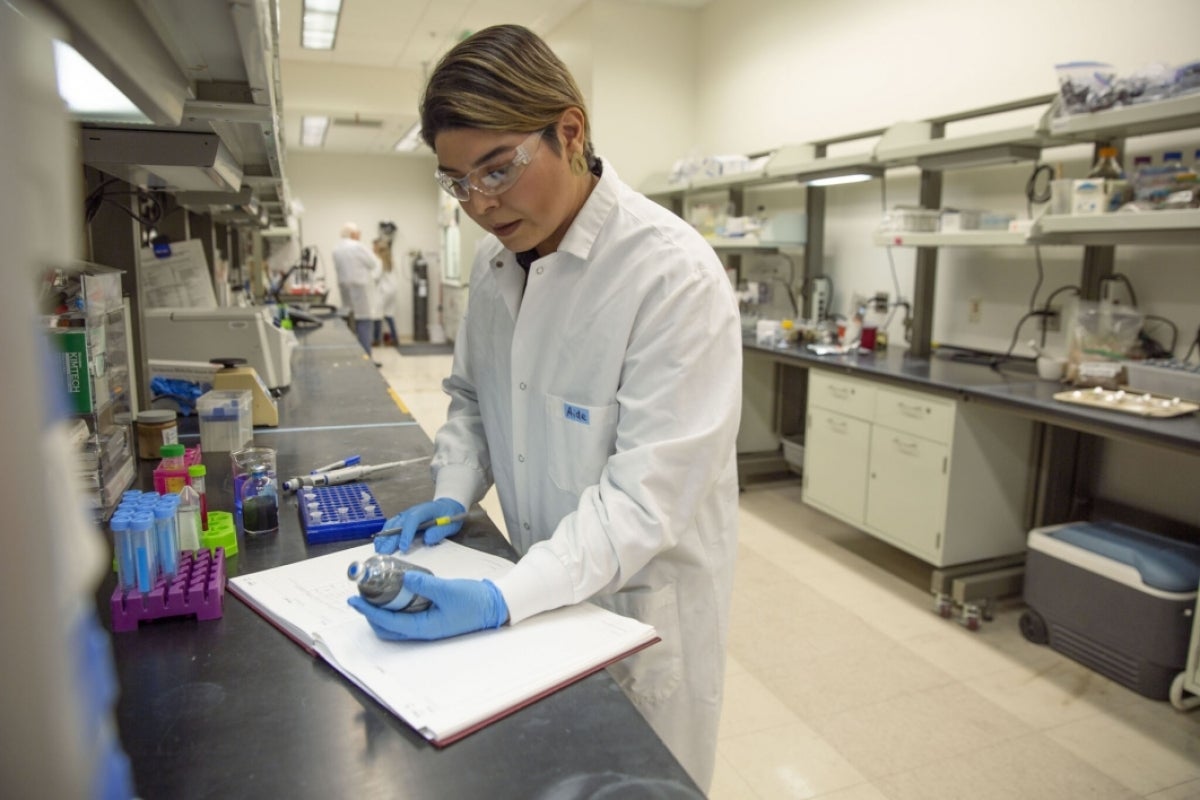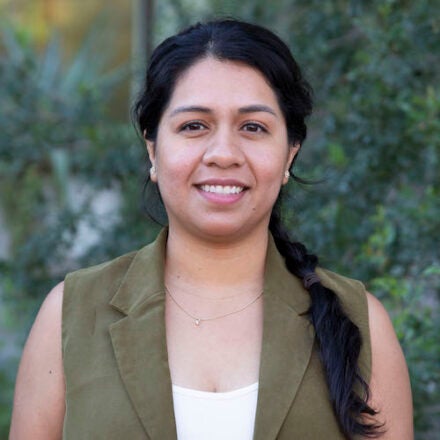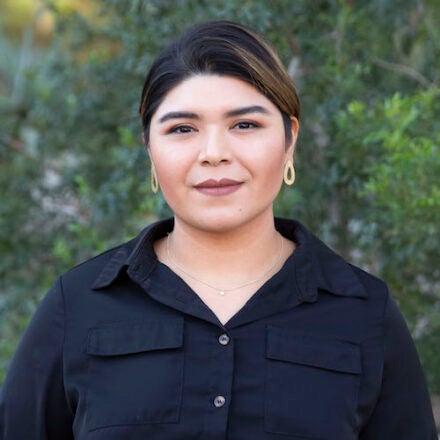Graduate students connect with industry through use-inspired research

In addition to completing internships during the fall 2022 semester, Justin Skinner, Aide Robles and Evelyn Miranda (pictured left to right) hold research positions in the lab of Anca Delgado, an assistant professor of environmental engineering in the Ira A. Fulton Schools of Engineering at Arizona State University. Photo by Monica Williams/ASU
Presented with the opportunity to gain industry experience before graduation, engineering doctoral students Justin Skinner, Evelyn Miranda and Aide Robles jumped at the chance.
These three students — who are pursuing doctoral degrees in the Ira A. Fulton Schools of Engineering at Arizona State University — were selected as participants in the National Science Foundation, or NSF, Non-Academic Research Internships for Graduate Students program. Skinner and Robles are in the School of Sustainable Engineering and the Built Environment while Miranda is in the School for Engineering of Matter, Transport and Energy. These are two of the seven schools in the Fulton Schools.
Under the program, NSF provides financial support of up to $55,000 for each graduate student to work at a sponsoring firm for up to six months to augment their research endeavors with nonacademic internships and training opportunities.
“This is a great opportunity for ASU's partner firms to get six months of engineering support from a highly trained graduate student in an area related to their research interests,” says Anca Delgado, an assistant professor of environmental engineering.
The students work in Delgado's lab in the ASU Biodesign Institute's Swette Center for Environmental Biotechnology on research projects that are part of the NSF Engineering Research Center for Bio-mediated & Bio-inspired Geotechnics.
Below, Skinner, Miranda and Robles share how the internship experience helped shape their learning and career goals.
Justin Skinner
Justin Skinner
Degree: PhD in civil, environmental and sustainable engineering
Anticipated graduation: December 2023
Internship: Haley & Aldrich
Dissertation focus:
Skinner has two main focuses: the microbial defluorination of groundwater contaminants (per- and polyfluoroalkyl substances, known as PFAS) and experiments to enhance control of aerobic cometabolism-based groundwater remediation schemes. First, he aims to identify PFAS' effects on microbial communities and enrich a bacterial culture capable of PFAS biodegradation. Second, his research seeks to understand conditions under which aerobic cometabolism-based groundwater treatment regimes function or falter in order to make alterations that enhance treatment outcomes. He performs experiments that aim to enhance growth rate control of trichloroethylene cometabolizing bacterial communities.
Question: What work are you completing during your internship?
Answer: I am writing a guidance document for the implementation of in situ aerobic cometabolism of regulated groundwater contaminants. This involves the injection of bacteria into the subsurface to degrade pollution harmful to the environment and human health. I am also involved in remediation of sites where aerobic cometabolism may be deployed for pollutant remediation.
Q: How does this internship connect to your future career goals?
A: I would like to work in industry as a practitioner of bioremediation, cleaning up contaminated land.
Q: What skills did you learn in the classroom that you are now applying in your internship?
A: I am utilizing data synthesis skills, which bring together knowledge from previous publications to create a cohesive view of the current state of the science being used for bioremediation and industry practices. These previous discoveries are key to understanding how environmental processes are measured and modeled.
Q: How does receiving NSF funding contribute to your ability to complete such an internship?
A: This funding allows me to learn aspects of this profession that can only be learned in the field or a corporate setting, not in a lab or reading scientific publications.
Q: What is your motivation for studying the topics you have chosen to focus on?
A: I am studying the bioremediation of groundwater contaminants such as trichloroethylene, or TCE, and per- and polyfluoroalkyl substances, known as PFAS.
I am excited about bioremediation because it allows us to destroy pollution with natural bacteria, which is more sustainable and cost-effective than other treatment processes.
I have chosen specifically to focus on TCE and PFAS biodegradation because these are two common contaminants that cause environmental disturbances and human health problems. TCE is present in more than 80% of Superfund sites. PFAS is a relatively new focus, but recent federal laws have been enacted to reduce their usage.
Q: What influenced you to study at ASU?
A: I was inspired by ASU's focus on sustainability and the quality of the faculty and research.
Evelyn Miranda
Evelyn Miranda
Degree: PhD in biological design
Anticipated graduation: May 2023
Internship: Freeport-McMoRan Inc.
Dissertation focus:
Miranda's dissertation addresses the type of bioreactor operational designs, lignocellulosic materials and microbial communities that can be used for treating mining-influenced water. The goal is to understand the parameters that enable treatment for extended periods of time — an essential factor for abandoned mining sites.
Q: What work are you completing during your internship?
A: As an intern in the applied research and development sector of Freeport-McMoRan Inc., I am working on the optimization of bioreactors used to remediate mining-influenced water.
Mining-influenced water can be acidic, with high concentrations of heavy metals and sulfate. My work uses bioreactors to remove the heavy metals and sulfate as well as increase pH.
Q: How does this internship connect to your future career goals?
A: I plan to continue working in private-sector research. This internship gives me the opportunity to experience what research is like at the industry level, specifically research to reduce environmental impact.
Q: What skills did you learn in the classroom that you are now applying in your internship?
A: In the classroom, I learned about the application of microbial metabolisms and how they can be used to remove, transform or absorb contaminants in water and soil.
My current project focuses on using sulfate-reducing bacteria to produce sulfide. This sulfide precipitates or immobilizes the metals found in mining-influenced water, making it possible to capture those solid byproducts within the bioreactors.
Q: How does receiving NSF funding contribute to your ability to complete such an internship?
A: I am traveling part of the time to Tucson for my internship. I will also have opportunities to visit full-scale bioremediation systems treating water emerging from historical mines. Travel funds are included in the NSF funding, which helps offset the cost.
Q: What is your motivation for studying the topics you have chosen to focus on?
A: I am passionate about access to clean water, as I believe it is a basic human right. I like to believe I am contributing to the effort to make clean water universally available by focusing on sustainable, biologically based strategies.
Q: What influenced you to study at ASU?
A: I am a Phoenix native and a first-generation Mexican American college student. During my undergraduate studies, I received grants and scholarships, but ultimately it was not enough to live on my own. It helped that I was able to live with my family nearby and commute to school during my studies. I began my doctoral degree at ASU because I was awarded a two-year fellowship and had a network of people who supported and encouraged me to pursue it.
Aide Robles
Aide Robles
Degree: PhD in civil, environmental and sustainable engineering
Anticipated graduation: May 2023
Internship: Haley & Aldrich
Dissertation focus:
Robles' research is focused on use-inspired technology for bioremediation of chlorinated contaminants in the subsurface. Specifically, her work involves promoting anaerobic reductive dechlorination of chlorinated ethenes, the most commonly found legacy contaminants at Superfund sites.
Q: What work are you completing during your internship?
A: I am working on implementing my bioremediation approach at a Superfund site. This involves helping with the preparation of quarterly site reports, going on field visits and drafting a work plan for Environmental Protection Agency approval.
Q: How does this internship connect to your future career goals?
A: After graduation, I intend to join the industry sector. My top two choices are consulting and research and development. I believe this internship will make me a more competitive applicant. As a doctoral student, I've learned how to do great research, but I haven't had experience working with clients and applying my work in the field.
Q: What skills did you learn in the classroom that you are now applying in your internship?
A: Communication is the biggest skill that I am now applying. I am also using my knowledge in contaminant fate and transport, microbiology and bioremediation.
Q: How does receiving NSF funding contribute to your ability to complete such an internship?
A: The program has given me more flexibility than a traditional internship. I am able to gain consulting experience while completing portions of my doctoral dissertation.
Q: What is your motivation for studying the topics you have chosen to focus on?
A: My community and my love of science are my motivation. I am a second-generation Mexican American, and despite my parents’ hard work and efforts to provide a fulfilling childhood for me and my siblings, I had a difficult upbringing. My parents each have a sixth-grade education, and they wanted their children to have better access to schooling. School was an escape for me. It gave me a sense of purpose. I quickly learned that math came easily to me, so I pursued that avenue, which brought me to civil and environmental engineering. My experiences have fueled my passion to help solve our generation’s environmental issues.
Q: What influenced you to study at ASU?
A: Anca Delgado, my former master’s degree advisor who now serves as my doctoral advisor, was actually the one who convinced me to come to ASU. I was ready to start an accelerated program in hydrology on the East Coast when she reached out to me. I was fascinated by her work on chain elongation and bioremediation. Her work fascinated me so much that our meeting went over the time we had planned. I knew then that ASU was the right place for me.
More Science and technology

The Sun Devil who revolutionized kitty litter
If you have a cat, there’s a good chance you’re benefiting from the work of an Arizona State University alumna. In honor of…

ASU to host 2 new 51 Pegasi b Fellows, cementing leadership in exoplanet research
Arizona State University continues its rapid rise in planetary astronomy, welcoming two new 51 Pegasi b Fellows to its exoplanet…

ASU students win big at homeland security design challenge
By Cynthia GerberArizona State University students took home five prizes — including two first-place victories — from this year’s…







